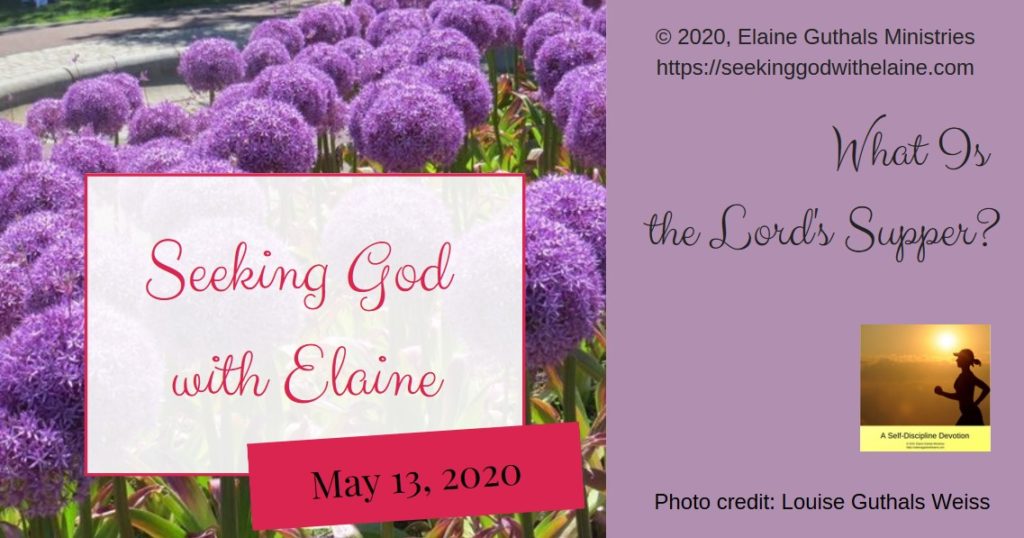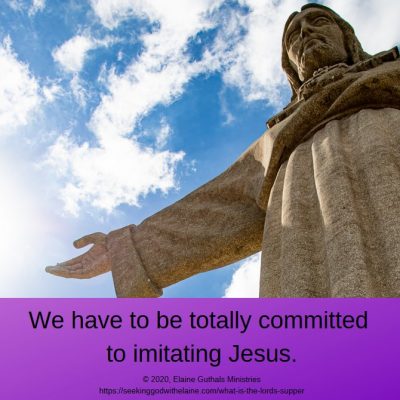The Lord’s Supper is a divine ordinance, but what does that mean? This devotion looks at the elements of the Lord’s Supper and why it is important to be obedience to Jesus’ instruction to continue the observance.
Nuggets
- The bread symbolizes Jesus’ body.
- Jesus’ blood, represented in the cup, had to be spilled.
- The Lord’s Supper – and baptism – were symbols of God’s new covenant with His people.
Devotions in the What I Believe series
Devotions in the Divine Ordinance category

I’ve always liked the story around the Lord’s Supper. “On the night He was betrayed …” “Do this in remembrance of Me.”
Jesus wanted to leave a lasting observance of what He did for us. We can reflect on the meaning.
Why is it important that we observe the Lord’s Supper? It is an ordinance.
Let's Put It into Context
We are looking at divine ordinances. Ordinances are an expression of the disciples’ obedience.
The second ordinance we will consider is the Lord’s Supper. The Holman Bible Dictionary defines the Lord’s Supper “a memorial celebrated by the early church to signify Jesus’ sacrificial death for humankind’s sin.”
The first Lord’s Supper was part of the Passover meal. God instituted the Passover festival. It was the oldest festival observed by the Jewish people. Jesus and His disciples, being good Jewish men, also observed it.
Passover preceded the Feast of Unleavened Bread, which commemorated Israel’s escape from their bondage in Egypt.
The Passover, with the Seder meal, was instituted in Exodus 12. They celebrated it the night before their exodus from Egypt. The Israelites are also commanded to observe the meal in Numbers 9 and Deuteronomy 16.
The Passover meal ends with a “same bat-time” but a different “bat-channel.” It was always their hope that they would be celebrating Passover next year in Jerusalem. This is significant because that would mean the Messiah had come.
To read a related devotion, click the button below.
The Symbol of the Bread
“As they were eating, Jesus took bread, blessed and broke it, gave it to the disciples, and said, ‘Take and eat it; this is my body’” (Mt. 26: 26 CSB)
We talked about the symbolism of baptism. The Lord’s Supper also has symbolism.
The first symbol is the bread. We’ve already talked about that a Jesus was the Bread of Life. “‘I am the bread of life,’ Jesus told them. ‘No one who comes to me will ever be hungry, and no one who believes in me will ever be thirsty again’” (Jn. 6: 35 CSB).
The bread symbolizes Jesus’ body. The brokenness is important as it was for us that He was broken.
Irons noted that the focus was to be on Jesus “… the glorious, perfect, complete God-Man.” What is symbolized here is His being the way to salvation.
Remember, this was after they ate the Passover meal. Lamb, known as the Pascal Lamb, was part of the meal. The lamb was considered a sacrifice for the meal. It was to symbolize the coming Messiah.
Jesus was also known as the Lamb because He is the Messiah. He was the Sacrifice for our sins.
When we think of eating, we think of the food nourishing our bodies. It sustains our lives. It not only keeps us healthy but also restores our health. (Can we say chicken soup?)
Jesus gives us eternal life when we believe in Him. He has restored our health — our relationship with God. Then we remain healthy as we abide in Him.
For the Passover meal, the Israelites were to eat the whole lamb. That explains what our attitude as a disciple should be — all committed to Jesus. We shouldn’t be a nominal disciple.
We have to be totally committed to imitating Jesus. That means we try to do the do’s and not do the don’ts.

The Symbol of the Cup
“Then he took a cup, and after giving thanks, he gave it to them and said, ‘Drink from it, all of you’” (Mt. 26: 27 CSB)
When we eat the food, we generally have a drink to go along with it.
The second symbol in the Lord’s Supper is the cup. It symbolizes the blood shed by Jesus.
Foster brought up how the juice is extracted from the grapes. The first thing that popped into my mind was a big tub with people jumping in to stomp the grapes. Even if a machine is used, force is utilized.
Jesus’ blood had to be spilt. It is through His blood that we gained atonement.
That blood was spilt when the soldiers forcibly drove the nails into Jesus’ hands and feet. They forcibly placed a crown of thorns on His head. Much force was used when the soldiers whipped Jesus.
The New Covenant
“For this is my blood of the covenant, which is poured out for many for the forgiveness of sins” (Mt. 26: 28 CSB)
The Lord’s Supper – and baptism – were symbols of God’s new covenant with His people. It was no longer just for the Jews. Gentiles could be covenant people, also.
It was no longer based on what God’s people did or didn’t do. It was based on what Jesus did for us.
The only thing we were required to do is ABCD.
The ABCDs of Salvation
If you have not become a believer in Christ, please read through the
Plan of Salvation and prayerfully consider what God is asking you to do.
A – admit our sins
B – believe His Son Jesus is our Redeemer
C – confess God as Sovereign Lord
D – demonstrate that commitment by making any changes needed in our lives to
live the way in which God has called us
The Disciple’s Job Description
Making the Connections
Foster pointed out the simplicity of Jesus’ instructions. “… Take and eat … Drink …” (Mt. 26: 26-27 CSB). Jesus isn’t going to give us instructions without making sure we understand them. Yeah, it may take us a little bit to figure it out.
But what are we doing when we are trying to figure it out? We are growing closer to Him. We are learning to be the disciples Jesus wants us to be.
Foster goes on to further identify the purpose of the Lord’s Supper. He wrote, “We are taught that our eating the bread and drinking the cup is a confession of Christ, a pledge to serve our Lord, and an act of fellowship as Christians. But it is, above all, a reception of Christ by faith. Our very act of taking the bread symbolizes the way in which we are to be benefited by Christ. We can not have Christ except as we open our hearts to Him.”
Making the Connections to Self-Discipline
We’ve been asking these questions all along so we can prepare for when we are asked. Here is the worksheet again. What would you say about observing the Lord’s Supper?
- What does the Scriptures say?
- What do I believe?
- Why do I believe the same/differently than the Scriptures?
- What are the talking points when witnessing to a non-believer?
Related Links
I have created a worksheet of the questions above. Click on the button below to access it.
How Do We Apply This?
Jesus gave us no timeline as to when to observe the Lord’s Supper. He didn’t say daily, weekly, quarterly, or yearly. He just said “… do this in remembrance of me
(Lk. 22: 19 NIV).
Well, we could sit there and look at the elements. Maybe we could paint a picture of them.
If we don’t partake do the Lord’s Supper, it does us no good.
But we aren’t talking a nice evening meal with the significant other or BFFs. We are talking a revenant ceremony to remember a Savior.
Jesus said do it. We need to be obedient and do it.
I like when Foster said that we have to open our hearts to Jesus. Yes, partake of the Lord’s Supper as a remembrance of Him. It should also be as a confirmation of who we are in Him and a commitment to follow Him wherever He calls us. It should be a plea to fix what is wrong in us.
We have to prepare our hearts and minds to let Jesus in. We can’t close Him out and expect it to be more than just a ceremony.
We should use this time to evaluate where we are in our journey. The Holy Spirit will nudge us as to what we need to work on. Then, we need the self-discipline to follow His lead.
Father. We are visual people. You gave us a way to see and experience Jesus’ death. Lord, it takes our concentration to focus on You. Help us to prepare ourselves for the Supper. Help us to use the time to evaluate our lives to determine areas that need our work through Your guidance. Use this time to help us grow closer to You. Amen.
What do you think?
Leave me a comment below (about this or anything else) or head over to my Facebook group for some interactive discussion.
If you don’t understand something and would like further clarification, please contact me.
If you have not signed up for the email daily or weekly providing the link to the devotions and the newsletter, do so below.
If God has used this devotion to speak with you, consider sharing it on social media.
Pingback: The Promises of Jesus’ Return – Seeking God with Elaine
Pingback: Instituting the Lord’s Supper – Seeking God with Elaine
Pingback: The State of the Kingdom of God – Seeking God with Elaine